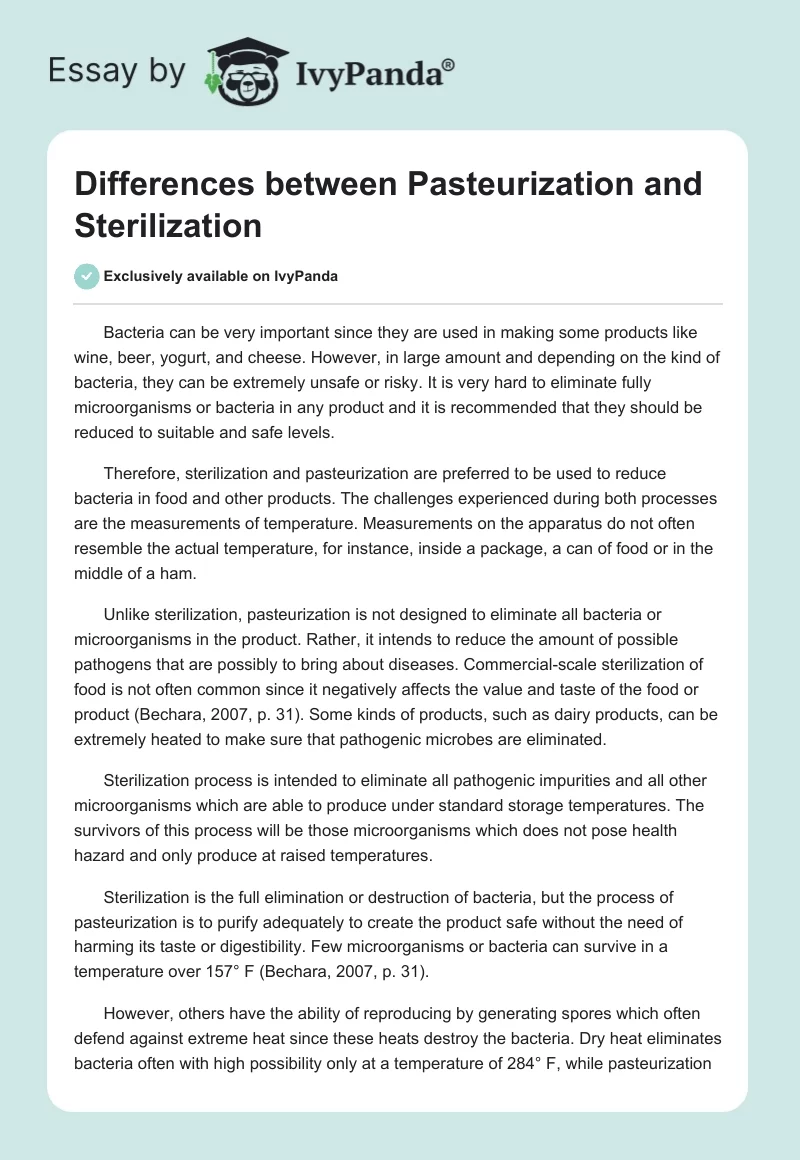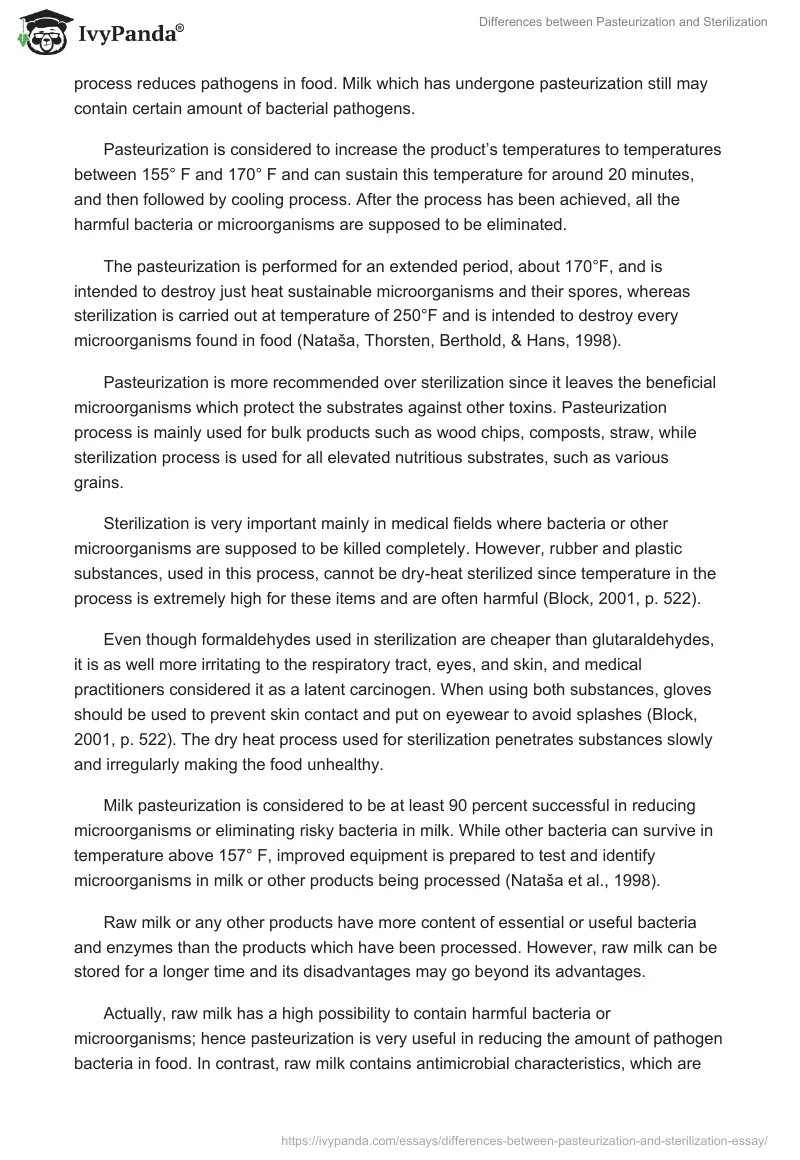Bacteria can be very important since they are used in making some products like wine, beer, yogurt, and cheese. However, in large amount and depending on the kind of bacteria, they can be extremely unsafe or risky. It is very hard to eliminate fully microorganisms or bacteria in any product and it is recommended that they should be reduced to suitable and safe levels.
Therefore, sterilization and pasteurization are preferred to be used to reduce bacteria in food and other products. The challenges experienced during both processes are the measurements of temperature. Measurements on the apparatus do not often resemble the actual temperature, for instance, inside a package, a can of food or in the middle of a ham.
Unlike sterilization, pasteurization is not designed to eliminate all bacteria or microorganisms in the product. Rather, it intends to reduce the amount of possible pathogens that are possibly to bring about diseases. Commercial-scale sterilization of food is not often common since it negatively affects the value and taste of the food or product (Bechara, 2007, p. 31). Some kinds of products, such as dairy products, can be extremely heated to make sure that pathogenic microbes are eliminated.
Sterilization process is intended to eliminate all pathogenic impurities and all other microorganisms which are able to produce under standard storage temperatures. The survivors of this process will be those microorganisms which does not pose health hazard and only produce at raised temperatures.
Sterilization is the full elimination or destruction of bacteria, but the process of pasteurization is to purify adequately to create the product safe without the need of harming its taste or digestibility. Few microorganisms or bacteria can survive in a temperature over 157° F (Bechara, 2007, p. 31).
However, others have the ability of reproducing by generating spores which often defend against extreme heat since these heats destroy the bacteria. Dry heat eliminates bacteria often with high possibility only at a temperature of 284° F, while pasteurization process reduces pathogens in food. Milk which has undergone pasteurization still may contain certain amount of bacterial pathogens.
Pasteurization is considered to increase the product’s temperatures to temperatures between 155° F and 170° F and can sustain this temperature for around 20 minutes, and then followed by cooling process. After the process has been achieved, all the harmful bacteria or microorganisms are supposed to be eliminated.
The pasteurization is performed for an extended period, about 170°F, and is intended to destroy just heat sustainable microorganisms and their spores, whereas sterilization is carried out at temperature of 250°F and is intended to destroy every microorganisms found in food (Nataša, Thorsten, Berthold, & Hans, 1998).
Pasteurization is more recommended over sterilization since it leaves the beneficial microorganisms which protect the substrates against other toxins. Pasteurization process is mainly used for bulk products such as wood chips, composts, straw, while sterilization process is used for all elevated nutritious substrates, such as various grains.
Sterilization is very important mainly in medical fields where bacteria or other microorganisms are supposed to be killed completely. However, rubber and plastic substances, used in this process, cannot be dry-heat sterilized since temperature in the process is extremely high for these items and are often harmful (Block, 2001, p. 522).
Even though formaldehydes used in sterilization are cheaper than glutaraldehydes, it is as well more irritating to the respiratory tract, eyes, and skin, and medical practitioners considered it as a latent carcinogen. When using both substances, gloves should be used to prevent skin contact and put on eyewear to avoid splashes (Block, 2001, p. 522). The dry heat process used for sterilization penetrates substances slowly and irregularly making the food unhealthy.
Milk pasteurization is considered to be at least 90 percent successful in reducing microorganisms or eliminating risky bacteria in milk. While other bacteria can survive in temperature above 157° F, improved equipment is prepared to test and identify microorganisms in milk or other products being processed (Nataša et al., 1998).
Raw milk or any other products have more content of essential or useful bacteria and enzymes than the products which have been processed. However, raw milk can be stored for a longer time and its disadvantages may go beyond its advantages.
Actually, raw milk has a high possibility to contain harmful bacteria or microorganisms; hence pasteurization is very useful in reducing the amount of pathogen bacteria in food. In contrast, raw milk contains antimicrobial characteristics, which are eliminated during the process of pasteurization, as well as various vitamins which are supposed to be available in milk.
Pasteurization of products does not affect nutrient composition and content, while sterilization process reduces accessible nutrients in food. It is evidently that pasteurization maintains the nutrients content of the food, as it eliminates harmful microorganisms, mostly bacteria, in the food. Thus, if heat process is needed in any product to prevent any risks posed by bacteria, pasteurization is recommended than sterilization in sustaining the amount of accessible nutrients and the product’s taste (Nataša et al., 1998).
References
Bechara, M. (2007). Alternative Mushroom Production Systems Using Non-composted Grain-based Substrates. Ann Arbor, MI: ProQuest.
Block, S. (2001). Disinfection, Sterilization, and Preservation. Philadelphia, PA: Lippincott Williams & Wilkins.
Nataša, F., Thorsten, S., Berthold, K., & Hans, D. (1998). Effects of Human Milk Pasteurization and Sterilization on Available Fat Content and Fatty Acid Composition. Journal of Pediatric Gastroenterology & Nutrition , 27(3): 317-322.


